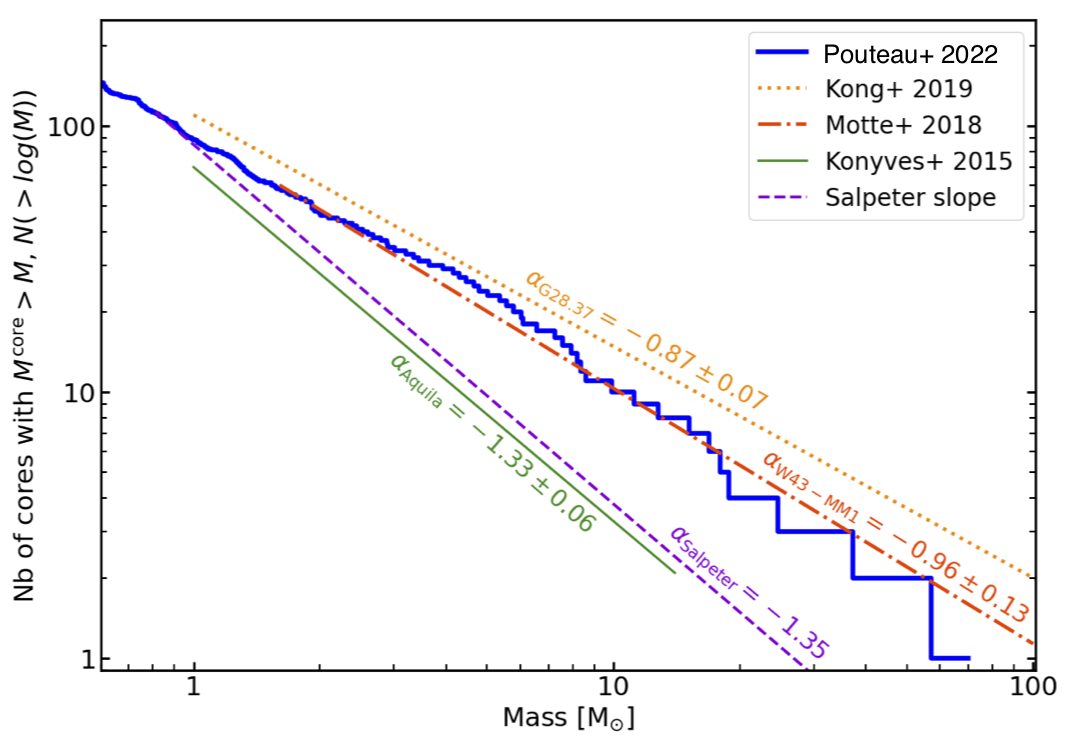- To move slides, use the arrow keys or swipe on your mobile device
- To go to full screen, press "f"
- To print as PDF, go to this URL:
?print-pdf, then print (warning: may be slow and not work on all browsers).
- To see an overview, press esc
Hot Cores and the CMF
Adam Ginsburg
Assistant Professor
Department of Astronomy
University of Florida, Gainesville
with the ALMA-IMF team (incl. Timea Csengeri, Melisse Bonfand, Thomas Nony), postdoc Allison Towner, and students
Desmond Jeff, Theo Richardson, Alyssa Bulatek, Nazar Budaiev,
and Savannah Gramze
Slides available at
https://keflavich.github.io/talks/starstogalaxies2022_hotcores.html
Meet my group
 49 Theo Richardson:
49 Theo Richardson:YSO radiative transfer modeling |
 54 Nazar Budaiev: Protostars & cores in Sgr B2
54 Nazar Budaiev: Protostars & cores in Sgr B2
|
 55 Desmond Jeff:
55 Desmond Jeff:Hot Cores in Sgr B2 DS |
 66 Allison Towner (postdoc): SiO in ALMA-IMF (at low velocities)
66 Allison Towner (postdoc): SiO in ALMA-IMF (at low velocities)
|
 157 Savannah Gramze:
157 Savannah Gramze:Overshooting and crashing gas along the Galactic bar |
 160 Alyssa Bulatek:
160 Alyssa Bulatek:Lines as tracers of physical processes in The Brick |
Summary
- Hot cores are where high-mass, forming young stars feed back onto their environments
- They suppress fragmentation by heating the gas
ALMA-IMF: $\sim800$ cores

Pouteau+ 2022 W43-MM2/3
ALMA-IMF:

Top-heavier IMFs are seen in high-mass clusters,



ALMA-IMF:
The CMF is shallow (top-heavy) in HMSFRs

Top-heavier IMFs are seen in high-mass clusters,
CMFs in protoclusters
Hot cores in ALMA-IMF: From rare objects to a population ($\sim50$)

Cores with line forests
TD>50 K
TG ≳100K
TD>50 K
TG ≳100K
Brouillet+, resubmitted

Bonfand+ (last talk): CH3OCHO HC catalog ($T\gtrsim100$ K)

Many lines of CH3OCHO toward W51-E2



 Desmond Jeff:
Desmond Jeff:
Ten hot cores in Sgr B2 DS
TG ~ 200-500 K
M ~ 200 - 2900 M⊙

Hot cores are generally the most massive cores

Hot cores are mostly small ($\lesssim5000$ AU)

The characteristic fragmentation scale is larger near HCs
Jeans Mass
MJ ∝ T3/2 ρ−1/2
HCs don't fragment in our data
No clear cases of another core existing with the radius (as seen in CH3OCHO) of a hot core in ALMA-IMF data (2000 AU resolution).
Limited fragmentation at higher resolution. |

|
HCs don't fragment in our data
No clear cases of another core existing with the radius (as seen in CH3OCHO) of a hot core in ALMA-IMF data (2000 AU resolution).
Limited fragmentation at higher resolution. |

|
Hot cores in the Galactic center

 Desmond Jeff:
Desmond Jeff:
Ten hot cores in Sgr B2 DS
TG ~ 200-500 K
M ~ 200 - 2900 M⊙
Hot cores in the CMZ are a bit hotter and more massive

Summary
- Hot cores are where high-mass, forming young stars feed back onto their environments
- They suppress fragmentation by heating the gas